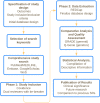Genetic variants associated with the occurrence and progression of adolescent idiopathic scoliosis: a systematic review protocol
- PMID: 35681176
- PMCID: PMC9178937
- DOI: 10.1186/s13643-022-01991-8
Genetic variants associated with the occurrence and progression of adolescent idiopathic scoliosis: a systematic review protocol
Abstract
Background: Adolescent idiopathic scoliosis (AIS) is a structural lateral spinal curvature of ≥ 10° with rotation. Approximately 2-3% of children in most populations are affected with AIS, and this condition is responsible for approximately $1.1 billion in surgical costs to the US healthcare system. Although a genetic factor for AIS has been demonstrated for decades, with multiple potentially contributory loci identified across populations, treatment options have remained limited to bracing and surgery.
Methods: The databases MEDLINE (via PubMed), Embase, Google Scholar, and Ovid MEDLINE will be searched and limited to articles in English. We will conduct title and abstract, full-text, and data extraction screening through Covidence, followed by data transfer to a custom REDCap database. Quality assessment will be confirmed by multiple reviewers. Studies containing variant-level data (i.e., GWAS, exome sequencing) for AIS subjects and controls will be considered. Outcomes of interest will include presence/absence of AIS, scoliosis curve severity, scoliosis curve progression, and presence/absence of nucleotide-level variants. Analyses will include odds ratios and relative risk assessments, and subgroup analysis (i.e., males vs. females, age groups) may be applied. Quality assessment tools will include GRADE and Q-Genie for genetic studies.
Discussion: In this systematic review, we seek to evaluate the quality of genetic evidence for AIS to better inform research efforts, to ultimately improve the quality of patient care and diagnosis.
Systematic review registration: PROSPERO registration #CRD42021243253.
Keywords: Adolescent idiopathic scoliosis (AIS); Exome sequencing; Genetic studies; Genome-wide association; Protocol; Systematic review; Targeted sequencing; Variants; Whole genome sequencing.
© 2022. The Author(s).
Conflict of interest statement
NHM declares the following interests: grant funding from the National Institutes of Health, National Institutes of Arthritis and Musculoskeletal and Skin Diseases; Pediatric Orthopedic Society of North America, and Scoliosis Research Society. All other authors declare that they have no competing interests.
Figures
Similar articles
-
Association between genetic polymorphisms and risk of adolescent idiopathic scoliosis in case-control studies: a systematic review.J Med Genet. 2024 Jan 19;61(2):196-206. doi: 10.1136/jmg-2022-108993. J Med Genet. 2024. PMID: 37696603
-
The effectiveness of selective thoracic fusion for treating adolescent idiopathic scoliosis: a systematic review protocol.JBI Database System Rev Implement Rep. 2015 Nov;13(11):4-16. doi: 10.11124/jbisrir-2015-2338. JBI Database System Rev Implement Rep. 2015. PMID: 26657460
-
The outcome of a modified version of the Cheneau brace in adolescent idiopathic scoliosis (AIS) based on SRS and SOSORT criteria: a retrospective study.Eur J Phys Rehabil Med. 2016 Oct;52(5):618-629. Epub 2016 May 4. Eur J Phys Rehabil Med. 2016. PMID: 27145218
-
MRI-based morphological evidence of spinal cord tethering predicts curve progression in adolescent idiopathic scoliosis.Spine J. 2015 Jun 1;15(6):1391-401. doi: 10.1016/j.spinee.2015.02.033. Epub 2015 Feb 25. Spine J. 2015. PMID: 25725365
-
Radiographic methods to estimate surgical outcomes based on spinal flexibility assessment in patients who have adolescent idiopathic scoliosis: A systematic review.Spine J. 2018 Nov;18(11):2128-2139. doi: 10.1016/j.spinee.2018.06.344. Epub 2018 Jun 26. Spine J. 2018. PMID: 29959103
Cited by
-
Congenital kyphoscoliosis: Analysis of vertebral abnormalities using model animals (Review).Exp Ther Med. 2024 Sep 4;28(5):416. doi: 10.3892/etm.2024.12705. eCollection 2024 Nov. Exp Ther Med. 2024. PMID: 39301254 Free PMC article. Review.
References
Publication types
MeSH terms
Grants and funding
LinkOut - more resources
Full Text Sources
Medical



